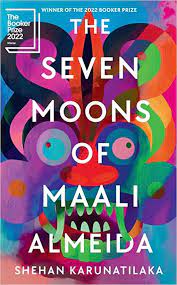Shehan Karunatilaka’s The Seven Moons of Maali Almeida (Sort of Books, 2022) won last year’s Booker Prize for its ‘energy, imagery and ideas [set] against a broad, surreal vision of the Sri Lankan civil wars’. We find that ‘surreal vision’ in its depiction of the afterlife—both the In Between (a version of purgatory), and the Light (a version of paradise/heaven).
In this brief schema, we can begin to recognise and appreciate how Karunatilaka’s text talks to other texts including, for instance, Dante’s epic trilogy The Divine Comedy and other ghostly texts, like Thomas Kyd’s 1589 play, The Spanish Tragedy. I want briefly to look at that a little more closely.
We could examine the general structure of visiting or being in the land of the dead. This is a long-lasting literary trope that we see in Philip Pullman’s turn-of-the-century His Dark Materials trilogy (1995–2000), Ursula Le Guin’s The Other Wind (2001), but these recent books are overshadowed by other works.
Notably, visiting the land of the dead—often categorised as the Underworld—forms a key part of any epic poem, including Homer’s the Iliad and the Odyssey (both 8th-century BCE), and Virgil’s Aeneid (19 BCE). Even in Derek Walcott’s 1990 epic poem Omeros, Walcott’s character visits the underworld in a dream. These visits are called nekuya in Ancient Greek, and are partly used to permit the visitor to the Underworld to realise the true value of being alive.
However, given the horror of its monstrous creations like the Mahakali, The Seven Moons draws me towards another epic. Looking at the demoniacal Mahakali, we see its
back is tattooed with letters and faces. [… T]he faces begin speaking to you. All at the same time, but this time, not in unison. Most of these souls are petrified and have been trapped here for longer than they know. Not all of them are human.
The Seven Moons of Maali Almeida by Shehan Karunatilaka (London: Sort of Books), p. 334
Something in this reminded me of the mythical creatures populating Dante’s Inferno (c. 1321), the mediaeval poet’s vision of hell. I think Inferno provides a more useful forebear than the other epic poems, in part because in that poem Dante, like Maali, is stuck in the land of the dead: there is no coming back for either protagonist.
There is one other major correlation worth pointing out. In the Inferno, Dante is guided by a character, Virgil:
‘The course I think would be the best for you,
Is to follow me, and I will act as your guide,
And show a way out of here, by a place in eternity,
Where you will hear the shrieks of men without hope[.]’
Inferno by Dante Aleghieri, I.112–15, trans. C.H. Sisson (Oxford: Oxford World’s Classics, 2008 [1980])
Virgil, barred from accessing Paradise because ‘”I was one of the rebels against his law”‘ (I.125), has to take Dante through hell in order to reach Purgatory, where he continues the journey without Virgil’s assistance.
This is a useful intertext to consider because of the way that Maali Almeida is offered competing guides in his underworld. There is Sena, the revolutionary who first shows Maalie the ropes of the In Between (pp. 24–6), and who later tries to recruit Maali to help kill other murderers; and there is also Dr Ranee Sridharan, ‘The university lecturer slain by Tamil extremists for the crime of being a Tamil moderate’ (p. 6). Dr Ranee is a Helper, tasked with guiding the recently dead to the Light, rather than to staying in the In Between.
These competing guides—Sena wants Maali to stay and help in the In Between; Dr Ranee wants Maali to make it to the heavenly Light—show how The Seven Moons is both engaging with its precursor epics, but also departing: an ideal model of intertextual reckoning.
One other way of thinking about the book is as a revenge novel. Far lass well known than the revenge play, prominent in the early modern period when Shakespeare was writing, this revenge novel nonetheless borrows a framework from one play in particular: Thomas Kyd’s 1589 The Spanish Tragedy. In the opening monologue, the wronged Don Andrea tells the audience that after his funeral ‘the ferryman of hell [was] content / To pass me over to the slimy strand, / That leads to fell Avernus’ ugly waves’ [1]—i.e. the underworld—from where he now sees the world of the living pass before his eyes.
Andrea is speaking to the Ghost of Revenge who replies that Andrea ‘shalt see the author of thy death / […] / Deprived of life by Bel-Imperia’ (1.1.87–9), Andrea’s former lover. Whilst not taking part in the revenge himself—unlike the protagonists of, say, Shakespeare’s Hamlet (1599) or Thomas Middleton’s The Revenger’s Tragedy (1606)—Andrea is nonetheless guided through the underworld by an embodied motive of Revenge.
When we read that Sena plans to make suffer the ‘death squad’ who murdered himself and (separately) Maali (p. 42), we recognise the structure of revenge. But we already think of Sena as a version of Dante’s Virgil, and of Andrea’s Revenge. The Seven Moons engages with these templates but amends and enlarges them to turn the mediaeval epic poem and tragic revenge play into a comic novel.
Many questions remain: What value does a Sri Lankan epic/comic/revenge novel place on these Western literary forms and tropes? What do a novel and novelist concerned with depicting real, tragic events in recent history, really care about these forms of writing? I don’t know any answers yet, but I’m interested in thinking about it more carefully.
[1] The Spanish Tragedy by Thomas Kyd, ed. Michaell Neil (New York, NY: W.W. Norton, 2014), 1.1.27–9.


Leave a Reply